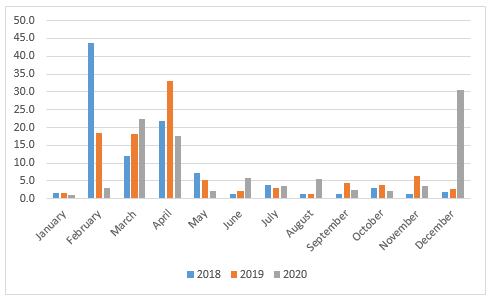Green Acres Update – 22 July 2021
Key management tips | Mortality rates | Antibiotic usage
Key management tips
- Complete second-cut silage harvesting if not already done.
- Clean out, wash and disinfect calf housing.
- Review calf rearing on farm. Was it a success? Were there issues with calf mortality and disease?
- Maintain pre-grazing covers at 1,500kg DM/ha and maintain 18-21 days ahead.
- Draft any remaining third-season cattle.
Mortality rates on Teagasc Green Acres farms
Calves lost to mortality on calf to beef farms are a cost to the system. Where higher than desired levels are recorded, the profitability of the system suffers. This occurs not only through the forgone purchase cost of the calf, but also through the variable costs associated with feeding, veterinary treatment and the knackery fee.
In calf to beef systems, mortality rates should not exceed 2% during the calf rearing period. The first 12 weeks on farm are the most challenging in terms of calf health. Not only are calves totally dependent on the operator to supply adequate levels of nutrition and the correct housing environment, the calf also makes the transition from a pre-ruminant to a ruminant animal.
Of the participating farms in the programme, 11 have purchased spring-born calves this year. As a collective group, mortality rates up to the end of June stood at 1.8% across programme farms. However, there’s a huge variation in mortality rates – ranging from 0% on four of the farms enrolled, up to 8% on one farm.
| Farm | Calves purchased | Calves lost | Mortality rate – % |
|---|---|---|---|
| 1 | 112 | 4 | 3.6 |
| 2 | 165 | 2 | 1.2 |
| 3 | 85 | 0 | 0 |
| 4 | 192 | 6 | 3.1 |
| 5 | 159 | 2 | 1.3 |
| 6 | 81 | 0 | 0 |
| 7 | 72 | 0 | 0 |
| 8 | 108 | 0 | 0 |
| 9 | 91 | 2 | 2.2 |
| 10 | 193 | 2 | 1 |
| 11 | 74 | 6 | 8.1 |
| Total | 1,332 | 24 | 1.8 |
Where mortality was an issue at farm level, now is the time to put in the appropriate steps to ensure that the problem is not repeated next spring. This may entail an examination of the calf sourcing, rearing or housing facilities to address the problem going forward.
In a climate where the use of antibiotics is being constantly examined in livestock production systems – with even more stringent rules appearing set to come down the track – a challenge at farm level is to ensure calves remain healthy. A number of key principles are required to ensure this is possible. Firstly, source a healthy calf from a herd with known health status. Provide the calf with the correct level of nutrition and housing environment, while the use of vaccinations – particularly for pneumonia and IBR – should be prioritised.
In terms of the calf health and mortality challenges being experienced at farm level, pneumonia and scour/bloat continue to remain the two primary causes of animal mortality on the Teagasc Green Acres farms.
At this point, it’s worth noting that weather conditions at farm level this spring were challenging, with the month of May proving particularly difficult. However, the fact that mortality rates are relatively high on some farms is still a concern.
Not only are mortality rates a cost to the system, the hidden costs in terms of morbidity must also be examined. Animals which suffer a disease set back on farm will exhibit reduced levels of liveweight gain going forward. Where this occurs, one of two things happen – the age at slaughter increases or the carcass weight produced falls – both of which have negative results on the profitability levels of calf to beef systems.
Antibiotic usage on Teagasc Green Acres farms
A study was completed earlier this year looking at the timing of antibiotic usage on the farms enrolled in the Teagasc Green Acres Calf to Beef Programme. Limited to farms with just calf to beef enterprises present at farm level, the results indicated that the majority of antibiotic usage coincides with calf rearing at farm level. The majority of antibiotic usage occurred over the months of February, March and April. A noticeable lag occurred in the mid-season of the year, when animals are at grass. In terms of the quantity of antibiotic used, an average of 29mg/kg of liveweight output was recorded across the six farms in 2020.

